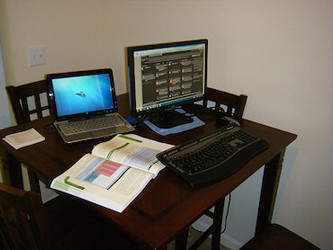Best Company Practices for Home Office Ergonomics
Posted by Gene Kay, MS, CPE on 11th Jul 2017
While there are many great reasons for corporate telecommuting and Home Office arrangements there are also considerable ergonomic, safety and security concerns employers need to address. Many papers, articles, and web sites such as Global Workplace Analytics report positive benefits from Home Work programs including; improved employee satisfaction, retention, productivity, and real estate cost savings. Yet, if you don't have a good process in place, there is an increased risk of bad outcomes.
The following best practice guide will increase your chances of having positive experience and enjoying good outcomes.
Companies considering Home Office ergonomics programs need to ensure that they have a good match with the right job, the right person, the right work environment & equipment, and the right training & support.
- The right job -- can this work be performed from a remote location, or does it require support from surrounding colleagues and co-workers?
- The right person -- does this person have the experience, skills, and performance capabilities to suggest they can be successful working at home, or do they require visible support and monitoring?
- The right work environment -- Does the proposed home office provide minimum health, safety, and security for your employees while they work on your behalf? You may want to know about the building, the neighborhood, outside disturbances, access, egress, door locks, data security, smoke detectors etc. How about room-mates, pet care, child care, elder care – or other factors that can detract from work performance.
- The right work equipment – Will the employee be working in an ergonomically correct environment, or will they be working from an ill-fitted kitchen table, on the couch, or in bed?
- At minimum, you should help your employees identify and select proper furniture and equipment that fits them well.
- Best practice is to provide them with the furniture or money to buy the furniture. For example, some firms provide a reasonable furniture and accessory budget to qualified home offices if the employee agrees to give up dedicated office space in the main office. This investment in good ergonomics is off-set by facilities cost savings and protected by an agreement in which payback is required if the employee leaves the company before 6 months time.
- The right training & support – In many countries around the world, computer users must have training and an evaluation of their set up. This is best practice everywhere. An on-line program training and assessment solution can help employees work at their best and provide management with the tools to effectively improve and document progress for remote office workers.
- The employee may also require training and support in how to communicate with other team members, or how to operate in the new more independent environment.
Ergoweb® and Ergobuyer® have everything you need to implement a best-in-class Home Office/ Telecommute program for your business. We have the furniture and equipment, and the knowledge and experience available to consult with your business policies, procedures, and practices.
Originally published on ergoweb.com June 17, 2015.

